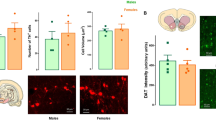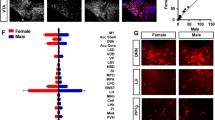Abstract
The relationship between circling behavior and the dopaminergic (DA) innervation of the striatum was investigated in rats. Vmax for DA uptake in crude mitochondrial (P2) fractions was used as a measure of the density of striatal DA terminals. Females, as a group, rotated away from (i.e., contralateral to) the side containing the higher V max for DA uptake, while there was a nonsignificant trend in the opposite direction for the males. Further analysis suggested that in both sexes there are two kinds, or populations, of rats: those with their turning biases directed away from (Contra>Ipsi rats), and those with their turning biases directed towards (Ipsi>Contra rats) the side containing the striatum with the higher V max for DA uptake. Evidence supporting this two-population hypothesis includes: (a) For both groups of rats the slope of the best fit linear relationship between the contralateral/ipsilateral V max asymmetry and rotational behavior is equal in magnitude, though opposite in sign; (b) Mean contralateral V max is greater for the Contra>Ipsi rats than for the Ipsi>Contra rats, while the mean ipsilateral V max is virtually identical for the two groups; (c) The two groups of rats can be differentiated behaviorally on the basis of a measure of total lateralized activity, % turning. In addition, the K m for DA uptake for the females (1.81±0.07×10−7 M) was found to be significantly greater than for the males (1.51±0.04×10−7 M; P<0.005).
Similar content being viewed by others
References
Becker JB, Robinson TE, Lorenz KA (1982) Sex differences and estrous cycle variations in amphetamine-elicited rotational behavior. Eur J Pharmacol 80:65–72
Bowman WC, Rand MJ (1980) Textbook of pharmacology, 2nd edition. Blackwell, Oxford
Brass CA, Glick SD (1981) Sex differences in drug-induced rotation in two strains of rats. Brain Res 223:229–234
Cools AR (1977) Two functionally and pharmacologically distinct dopamine receptors in the rat brain. Adv Biochem Psychopharmacol 16:215–225
Cools AR, van Rossum JM (1980) Multiple receptors for brain dopamine in behavior regulation: Concept of dopamine-e and dopamine-i receptors. Life Sci 27:1237–1253
Dark KA, Ellman G, Peeke HVS, Galin D, Reus VI (1984) Sex differences and asymmetries of catecholamines: Relation to turning preferences. Pharmacol Biochem Behav 20:327–330
De Long MR (1983) The neurophysiologic basis of abnormal movements in basal ganglia disorders. Neurobehav Toxicol Teratol 5:611–616
Dray A (1980) The physiology and pharmacology of mammalian basal ganglia. Prog Neurobiol 14:221–335
Evered D, O'Connor M (eds) (1984) Functions of the basal ganglia. Pitman, London
Fleisher LN, Glick SD (1979) Hallucinogen-induced rotational behavior in rats. Psychopharmacology 62:193–200
Frigyesi TL, Purpura DP (1967) Electrophysiological analysis of reciprocal caudato-nigral relations. Brain Res 6:440–456
Glick SD, Cox RD (1978) Nocturnal rotation in normal rats: Correlation with amphetamine-induced rotation and effects of nigrostriatal lesions. Brain Res 150:149–161
Glick SD, Cox RD, Jerussi TP, Greenstein S (1977) Normal and amphetamine-induced rotation of rats on a flat surface. J Pharm Pharmacol 29:51–52
Glick SD, Hinds PA, Shapiro RM (1983) Cocaine-induced rotation: Sex-dependent differences between left- and right-sided rats. Science 221:775–777
Gray EG, Whittaker VP (1962) The isolation of nerve endings from brain: An electron-microscopic study of cell fragments derived by homogenization and centrifugation. J Anat 96:79–88
Greenstein S, Glick SD (1975) Improved automated apparatus for recording rotation (circling behavior) in rats or mice. Pharmacol Biochem Behav 3:507–510
Groves PM (1983) A theory of the functional organization of the neostriatum and the neostriatal control of voluntary movement. Brain Res Rev 5:109–132
Hirschhorn ID, Hittner D, Gardner EL, Cubells J, Makman MH (1983) Evidence for a role of endogenous opioids in the nigrostriatal system: influence of naloxone and morphine on nigrostriatal dopaminergic supersensitivity. Brain Res 270:109–117
Jerussi TP, Glick SD (1976) Drug-induced rotation in rats without lesions: Behavioral and neurochemical indices of a normal asymmetry in nigrostriatal function. Psychopharmacology 47:249–260
Jerussi TP, Glick SD, Johnson CL (1977) Reciprocity of pre- and post-synaptic mechanisms involved in rotation as revealed by dopamine metabolism and adenylate cyclase stimulation. Brain Res 129:385–388
Kuhar MJ (1973) Neurotransmitter uptake: A tool in identifying neurotransmitter-specific pathways. Life Sci 13:1623–1634
Levi G, Raiteri M (1973) GABA and glutamate uptake by subcellular fractions enriched in synaptosomes: Critical evaluation of some methodological aspects. Brain Res 57:165–185
Lowry OH, Rosebrough NJ, Farr AL, Randall RJ (1951) Protein measurement with the folin phenol reagent. J Biol Chem 193:265–275
Miller JC (1983) Sex differences in dopaminergic and cholinergic activity and function in the nigro-striatal system of the rat. Psychoneuroendocrinology 8:225–236
Parker RB, Waud DR (1971) Pharmacological estimation of drug-receptor dissociation constants. Statistical evaluation. I. Agonists. J Pharmacol Exp Ther 177:1–12
Pycock CJ (1980) Turning behaviour in animals. Neurosci 5:461–514
Ross DA, Glick SD (1981) Lateralized effects of bilateral frontal cortex lesions in rats. Brain Res 210:379–382
Schultz W (1982) Depletion of dopamine in the striatum as an experimental model of Parkinsonism: Direct effects and adaptive mechanisms. Prog Neurobiol 18:121–162
Shoemaker H, Nickolson VJ (1983) Dopamine uptake by rat striatal synaptosomes: Time- and temperature-dependent decay and protection by dithiothreitol and dopamine. J Neurochem 40:922–928
Snedecor GW, Cochran WG (1967) Statistical methods, 6th edition. Iowa State University Press, Ames, Iowa
Sonsalla PK, Gibb JW, Hanson GR (1984) Opposite responses in the striato-nigral Substance P system to D1 and D2 receptor activation. Eur J Pharmacol 105:185–187
Stoof JC, Kebabian JW (1984) Two dopamine receptors: Biochemistry, physiology and pharmacology. Life Sci 35:2281–2296
Tassir JP, Cheramy A, Blanc G, Thierry AM, Glowinski J (1976) Topographical distribution of dopaminergic innervation and of dopaminergic receptors in the rat striatum. I. Microestimation of 3H-dopamine uptake and dopamine content in microdiscs. Brain Res 107:291–301
Thiebot M-H, Soubrie P (1979) Amphetamine-induced circling behavior in rats: Effects of unilateral microinjections of GABA and GABA-related drugs in substantia nigra. Brain Res 167:307–322
Tye NC, Horsman L, Wright FC, Large BT, Pullar IA (1977) Two dopamine receptors: Supportive evidence with the rat rotational model. Eur J Pharmacol 45:87–90
Ungerstedt U (1971a) Striatal dopamine release after amphetamine or nerve degeneration revealed by rotational behaviour. Acta Physiol Scand Suppl 367 (1971a) 367:49–68
Ungerstedt U (1971b) Postsynaptic supersensitivity after 6-hydroxydopamine induced degeneration of the nigrostriatal dopamine system. Acta Physiol Scand Suppl 367:69–93
Ungerstedt U, Arbuthnott GW (1970) Quantitative recording of rotational behavior in rats after 6-hydroxydopamine lesions of the nigrostriatal dopamine system. Brain Res 24:485–493
Vaccarino FJ, Franklin KBJ (1982a) Dopamine mediates ipsi- and contraversive circling elicited from the substantia nigra. Pharmacol Biochem Behav 17:431–434
Vaccarino FJ, Franklin KBJ (1982b) Self-stimulation and circling reveal functional differences between medial and lateral substantia nigra. Behav Brain Res 5:281–295
Whittaker VP, Barker LA (1972) The subcellular fractionation of brain tissue with special reference to the preparation of synaptosomes and their component organelles. In: Fried, RL (ed) Methods of neurochemistry, vol 2. Marcel Dekker, New York, pp 2–52
Yamamoto BK, Freed CR (1984) Reversal of amphetamine-induced circling preference in trained circling rats. Life Sci 34:675–682
Zimmerberg B, Glick SD, Jerussi TP (1974) Neurochemical correlate of a spatial preference in rats. Science 185:623–625
Author information
Authors and Affiliations
Rights and permissions
About this article
Cite this article
Shapiro, R.M., Glick, S.D. & Hough, L.B. Striatal dopamine uptake asymmetries and rotational behavior in unlesioned rats: revising the model?. Psychopharmacology 89, 25–30 (1986). https://doi.org/10.1007/BF00175184
Received:
Revised:
Issue Date:
DOI: https://doi.org/10.1007/BF00175184




